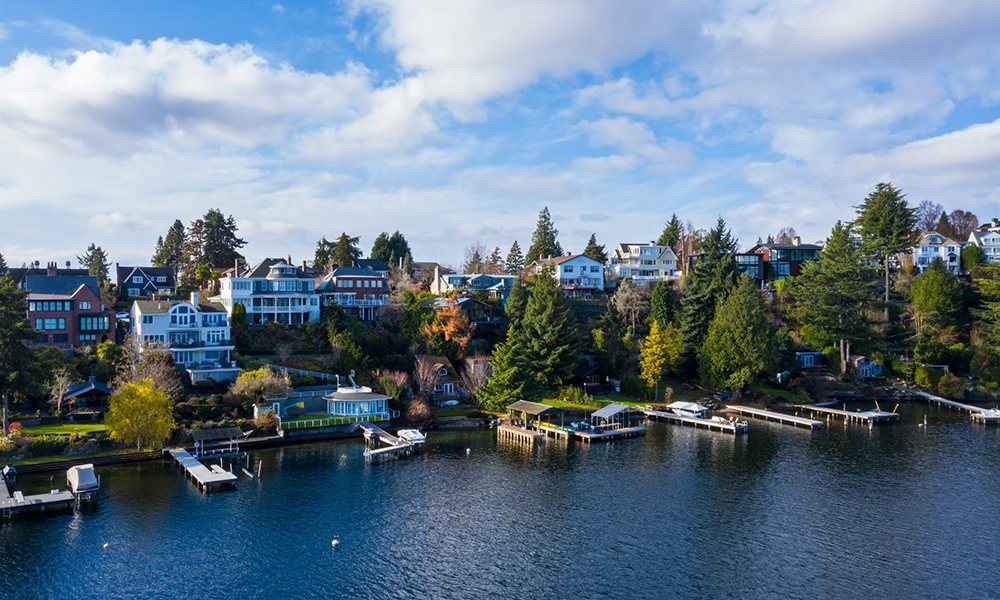
近期,美国各地的抵押贷款利率全线飙升,从2021年9月的3%上升到了上周三的7.33%。然而各地房地产市场对此的反应却是“冰火两重天”——低端住房市场火热得要命,而高端住宅市场则显著遇冷。
在美国的很多地区,高端住宅的下格都出现了下降,而低端住宅价格则并未受到太大影响。
以西雅图和旧金山这两个以高房价著称的城市为例,这两地的房价两极化趋势尤为明显。房地产网站Zillow的房价指数显示,西雅图和旧金山的“高端住宅”价格已分别下跌10.7%和13.4%。然而与此同时,两地的“低端住宅”价格跌幅则要小得多,仅分别为1.5%和4.1%。
这到底是怎么回事呢?首先,随着全美各地抵押贷款利率上升,居民的还贷压力陡增,很多购房者只得调整了他们的预期。既然购买高端房产已经成为一种奢望,购房者自然将目光投向了那些面积较小、价格也较为便宜的中低端住宅。这样一来,市场的中低端也就得以保持了一定的热度。
另外,很多改善型住房的买家原本可以接受3%到4%的抵押贷款利率,但现今6%到7%的还贷利率却让他们打消了换房的念头。这也导致了高端住宅的市场需求被进一步抑制,同时导致市场低端的库存供应进一步减少。
因此,在上述各种因素共同作用下,最近几个月,美国的低端市场表现一直显著好于高端市场。
在Zillow追踪的全美前40大房地产市场中,有29个市场的“高端价格层”仍低于疫情前的最高价格水平,有23个市场的“中端价格层”也尚未恢复疫情前的最高价格水平。但相比之下,只有10个市场的“低端价格层”仍低于疫情前的最高价格水平。
换句话说,今年7月份,在全美40个最大城市中,有30城的房市“低端价格层”创下历史新高,这也突显了经济实惠的房子对老百姓更有持久的吸引力。
同时,这种市场分化也存在着一定的地域差异。比如美国西部的凤凰城和旧金山等高房价地区的总体跌幅显著超过了芝加哥、辛辛那提等房价相对较低的中东部市场。特别值得注意的是,包括辛辛那提和芝加哥在内的11个地区的房价均在7月份创下历史新高。这种转变的一个重要原因是,很多被高房价逼走的购房者和投资者都将目光投向了芝加哥、辛辛那提和堪萨斯城等地。
换句话说,2023年上半年美国房产市场的总体趋势是放弃“买不起”的地方,涌向买得起的地方。这导致低端市场出现了较大幅度的价格上涨,而那些房价相对较低的地区同样也出现了一定幅度的价格上涨。(财富中文网)
注:本文中提到的“较低价格层”是指Zillow房价指数所追踪的5%至35%的房价区间。“中端价格层”是指35%到65%的房价区间。“高端价格层”是指65%到95%的房价区间。
译者:朴成奎
近期,美国各地的抵押贷款利率全线飙升,从2021年9月的3%上升到了上周三的7.33%。然而各地房地产市场对此的反应却是“冰火两重天”——低端住房市场火热得要命,而高端住宅市场则显著遇冷。
在美国的很多地区,高端住宅的下格都出现了下降,而低端住宅价格则并未受到太大影响。
以西雅图和旧金山这两个以高房价著称的城市为例,这两地的房价两极化趋势尤为明显。房地产网站Zillow的房价指数显示,西雅图和旧金山的“高端住宅”价格已分别下跌10.7%和13.4%。然而与此同时,两地的“低端住宅”价格跌幅则要小得多,仅分别为1.5%和4.1%。
这到底是怎么回事呢?首先,随着全美各地抵押贷款利率上升,居民的还贷压力陡增,很多购房者只得调整了他们的预期。既然购买高端房产已经成为一种奢望,购房者自然将目光投向了那些面积较小、价格也较为便宜的中低端住宅。这样一来,市场的中低端也就得以保持了一定的热度。
另外,很多改善型住房的买家原本可以接受3%到4%的抵押贷款利率,但现今6%到7%的还贷利率却让他们打消了换房的念头。这也导致了高端住宅的市场需求被进一步抑制,同时导致市场低端的库存供应进一步减少。
因此,在上述各种因素共同作用下,最近几个月,美国的低端市场表现一直显著好于高端市场。
在Zillow追踪的全美前40大房地产市场中,有29个市场的“高端价格层”仍低于疫情前的最高价格水平,有23个市场的“中端价格层”也尚未恢复疫情前的最高价格水平。但相比之下,只有10个市场的“低端价格层”仍低于疫情前的最高价格水平。
换句话说,今年7月份,在全美40个最大城市中,有30城的房市“低端价格层”创下历史新高,这也突显了经济实惠的房子对老百姓更有持久的吸引力。
同时,这种市场分化也存在着一定的地域差异。比如美国西部的凤凰城和旧金山等高房价地区的总体跌幅显著超过了芝加哥、辛辛那提等房价相对较低的中东部市场。特别值得注意的是,包括辛辛那提和芝加哥在内的11个地区的房价均在7月份创下历史新高。这种转变的一个重要原因是,很多被高房价逼走的购房者和投资者都将目光投向了芝加哥、辛辛那提和堪萨斯城等地。
换句话说,2023年上半年美国房产市场的总体趋势是放弃“买不起”的地方,涌向买得起的地方。这导致低端市场出现了较大幅度的价格上涨,而那些房价相对较低的地区同样也出现了一定幅度的价格上涨。(财富中文网)
注:本文中提到的“较低价格层”是指Zillow房价指数所追踪的5%至35%的房价区间。“中端价格层”是指35%到65%的房价区间。“高端价格层”是指65%到95%的房价区间。
译者:朴成奎
Mortgage rates have surged uniformly across the country, going from just 3% in September 2021 to 7.33% as of Wednesday. However, the response from housing prices has been anything but uniform, leading to a fascinating divergence in the nation’s housing market. It’s really a tale of two housing markets, one red-hot at the bottom and another ice-cold at the top.
In many regional housing markets, higher-end homes have experienced price declines, while starter homes have remained relatively unscathed.
Seattle and San Francisco, two markets renowned for their high-priced housing markets, epitomize this stark contrast in home values. According to the Zillow Home Value Index, “upper price tier” home values have plummeted by 10.7% and 13.4%, respectively, in Seattle and San Francisco. Meanwhile, “lower price tier” home values have seen far milder declines, with decreases of just 1.5% and 4.1% in Seattle and San Francisco, respectively.
What’s going on? As housing affordability deteriorated across the country under the weight of higher mortgage rates, homebuyers simply adjusted their expectations. With the upper echelons of the market out of reach for many buyers, they’ve turned with attention to smaller and lower-priced homes. In doing so, they’ve kept the bottom half of the market relatively warmer.
Furthermore, many move-up buyers, who would be trading in a 3% or 4% mortgage rate for a 6% or 7% rate, have chosen to remain in their current homes. Consequently, this results in a reduced influx of move-up demand into the “upper price tier,” while simultaneously decreasing the supply available in the “lower price tier.”
In recent months, lower-priced homes have consistently outperformed their higher-end counterparts.
Among the nation's 40 largest housing markets tracked by Zillow, 29 markets remain below their pandemic-era price peak in the "upper price tier," while 23 are yet to regain those peaks in the "middle price tier." In contrast, just 10 markets remain below their pandemic peak in the "lower price tier."
Put another way, 30 out of the nation's 40 largest housing markets set all-time highs for "lower price tier" homes in July, underscoring the enduring appeal of more affordable housing options.
We've also witnessed this bifurcation manifest regionally, as high-cost Western markets like Phoenix and San Francisco have experienced overall price declines surpassing those of their more affordable Midwestern counterparts, such as Cincinnati and Chicago. Remarkably, home prices in 11 markets, including Cincinnati and Chicago, reached new all-time highs across price tiers in July. One significant reason for this shift is that individuals and investors who had been priced out of markets like San Francisco and Austin are redirecting their focus toward cities like Chicago, Cincinnati, and Kansas City.
In other words, there was a run on “relative affordability” in the first half of 2023. It resulted in lower price tiers experiencing more substantial price gains and "relatively affordable markets" outperforming their less affordable counterparts in terms of price increases.
Note: "Lower price tier" reflects the typical value for homes tracked by the Zillow Home Value Index in the 5th to 35th percentile range. "Middle price tier" reflects the typical value for homes in the 35th to 65th percentile range. "Upper price tier" reflects the typical value for homes in the 65th to 95th percentile range.






